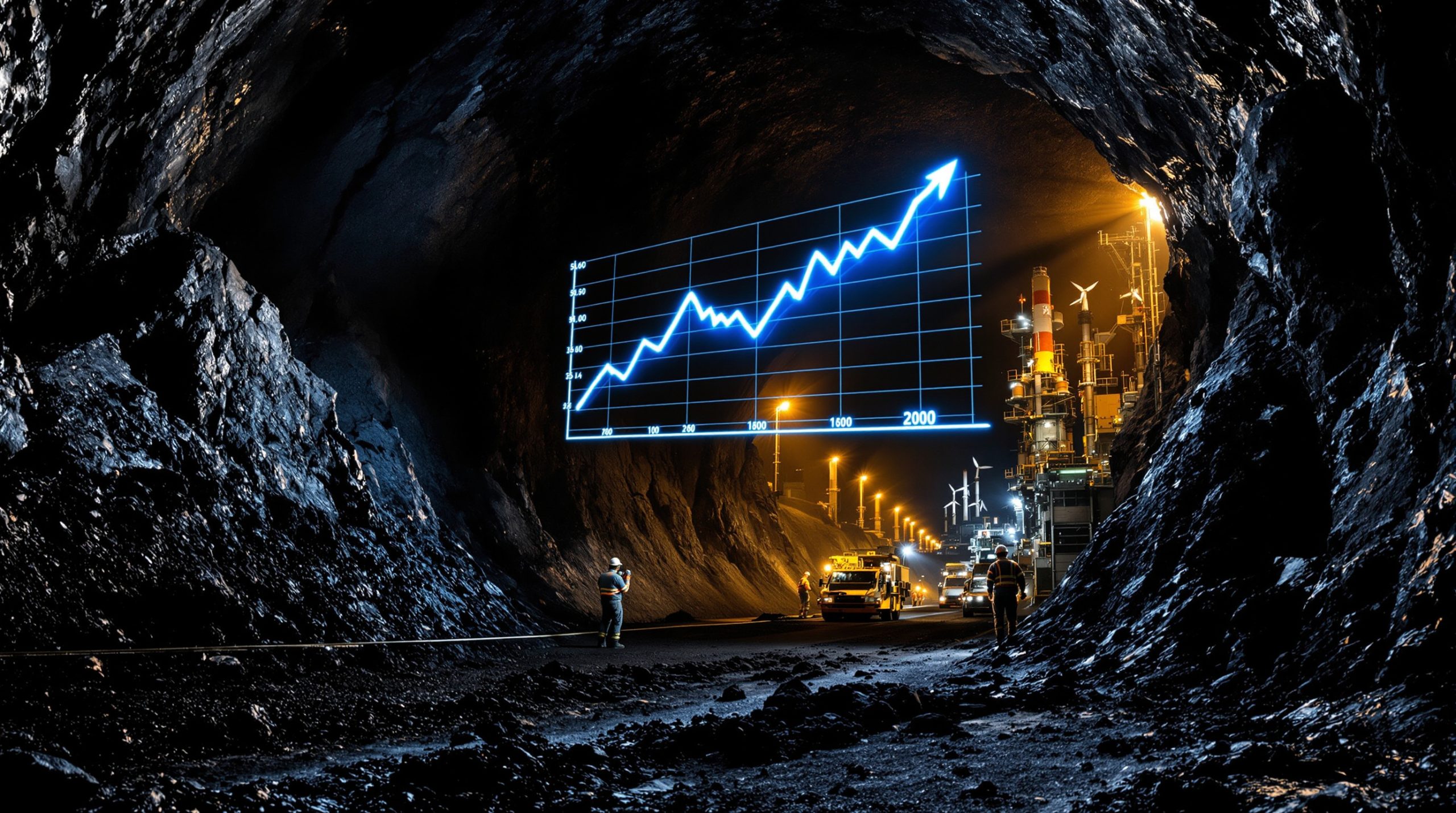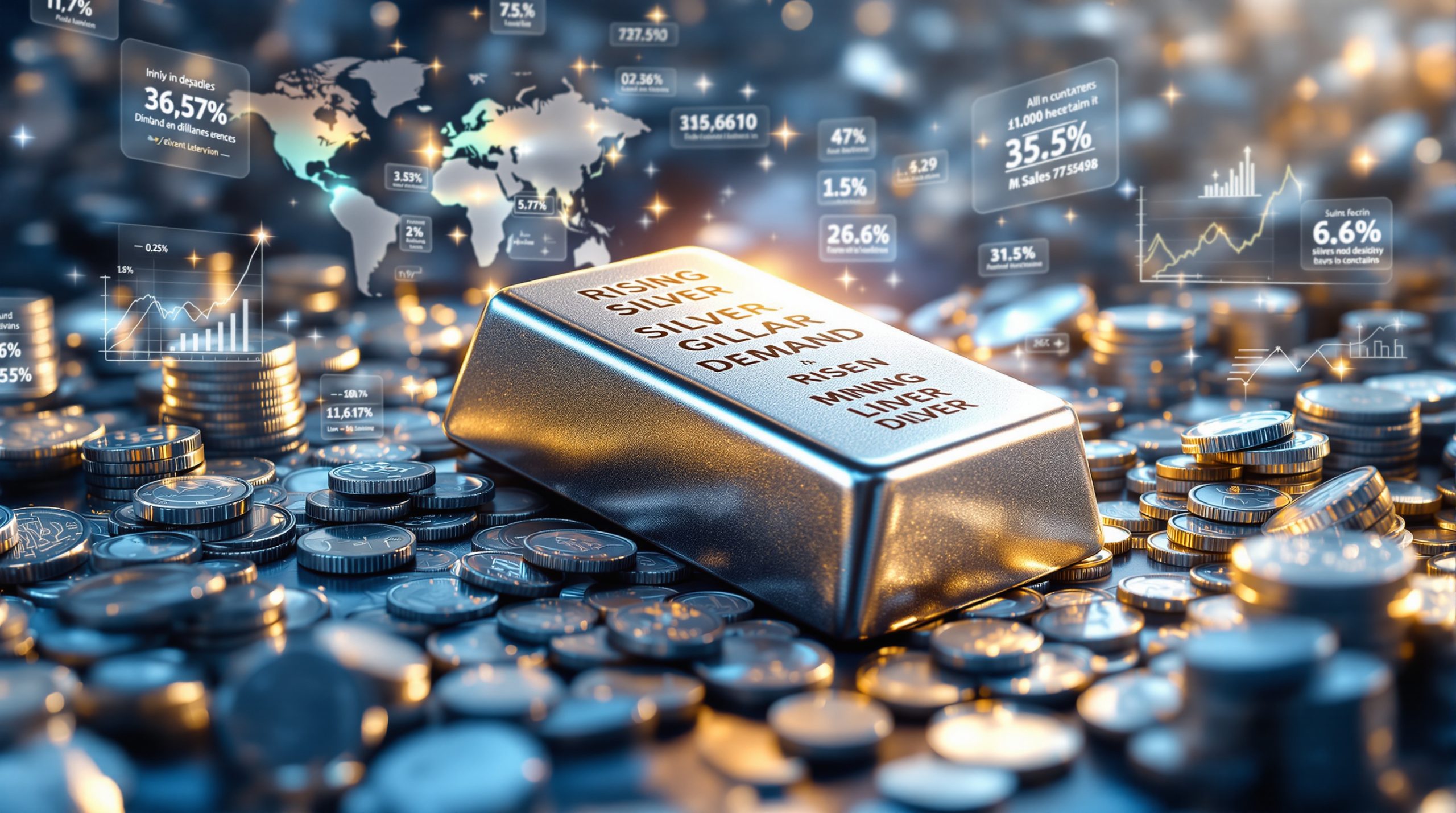Why Is the US Adding Silver to Its Critical Minerals List?
The United States Geological Survey's 2025 draft list proposes classifying silver as a critical mineral for the first time, marking a fundamental shift in how this versatile metal is viewed by policymakers. This designation would place silver alongside strategic materials like lithium, rare earths, and cobalt as resources essential to economic and national security.
Critical mineral status creates a legal framework for government intervention through strategic stockpiling programs, expedited permitting for domestic mining, potential tax incentives, research funding for recycling technologies, and trade policy protections for reliable supply partners.
This policy shift acknowledges silver's evolution from primarily a precious metal investment vehicle to an irreplaceable industrial material with applications across defense, renewable energy, and advanced technology sectors. Furthermore, silver market squeeze insights have highlighted the potential vulnerability in global supply chains.
Understanding the USGS Critical Minerals Framework
The Energy Act of 2020 established requirements for regular updates to the critical minerals list based on supply risk assessments and importance to economic and national security. This formal evaluation process examines vulnerability to supply disruption, concentration of production, and essentiality to key industrial sectors.
The proposed silver classification follows years of increasing industrial demand coupled with persistent supply deficits, creating conditions that meet the formal criteria for critical mineral designation.
The Strategic Shift: From Precious Metal to Industrial Essential
Silver's traditional role as a monetary metal and investment hedge is now complemented by its growing importance in technologies essential to both economic competitiveness and national security. This dual nature creates unique market dynamics as industrial demand becomes increasingly inelastic.
Industrial applications now account for more than half of annual silver consumption, marking a fundamental shift in demand patterns that policy frameworks are only now beginning to address through strategic classification. The critical minerals energy transition demonstrates how these materials are becoming increasingly vital to modern economies.
What Makes Silver Strategically Critical in 2025?
Renewable Energy's Growing Silver Appetite
Each solar photovoltaic panel contains approximately 20 grams of silver, used primarily in the conductive paste that collects and transmits electricity. This application alone is projected to consume nearly 30% of annual silver production by 2025, with further growth expected as renewable deployment accelerates.
Industry forecasts suggest solar deployment could eventually consume virtually all global silver production if technological alternatives aren't developed, creating strategic pressure to secure supply chains for clean energy infrastructure.
Defense Applications Requiring Silver's Unique Properties
Military systems rely on silver's superior conductivity and reliability in mission-critical applications where failure is not an option. These include:
- Satellite communications systems
- Guidance electronics for precision munitions
- Radar and surveillance equipment
- High-reliability circuit boards for battlefield communications
The Department of Defense considers these applications essential to national security, creating baseline demand independent of commercial market cycles. The Pentagon's interest in securing supply chains has prompted the development of a defense critical materials strategy to address potential vulnerabilities.
Semiconductor and Advanced Electronics Dependencies
The semiconductor industry uses silver in multiple critical manufacturing processes, including:
- Conductive pastes for die attachment
- Wire bonding materials
- EMI shielding components
- High-performance electrical contacts
As chip manufacturing becomes increasingly strategic to economic security, the materials required for production gain similar importance in policy frameworks.
How Will Critical Mineral Status Change Silver Markets?
Government Stockpiling Mechanisms and Their Market Impact
Critical mineral designation typically triggers multiple government purchasing mechanisms that create structural demand layers beyond traditional market fundamentals:
- The Defense Logistics Agency maintains strategic reserves of materials essential to military operations
- The Department of Energy supports stockpiles for materials critical to energy infrastructure
- Government contractors may maintain buffer inventories to ensure production continuity
Historical precedent from uranium and rare earths suggests these programs establish effective price floors during market downturns while reducing volatility.
Permitting Acceleration for Domestic Projects
Projects in strategic jurisdictions benefit from streamlined regulatory processes designed to enhance domestic supply security. These may include:
- Expedited environmental review timelines
- Coordinated permitting across federal agencies
- Technical assistance for compliance requirements
- Prioritization in review queues for critical materials
These advantages can reduce development timelines by 30-50% for qualifying projects, creating significant competitive advantages for domestic operators. The Trump critical minerals order previously attempted to address some of these permitting challenges.
Tax Incentives and Production Subsidies
Policy tools supporting domestic critical mineral production typically include:
- Production tax credits based on output volumes
- Investment tax credits for capital expenditures
- Accelerated depreciation for qualifying equipment
- Research grants for processing innovations
These incentives effectively reduce operating costs and improve return profiles for projects in secure jurisdictions, attracting investment capital that might otherwise flow to lower-cost international alternatives.
Which Countries Control the Global Silver Supply Chain?
Mexico's Dominant 25% Production Share
Mexico leads global silver production with approximately 6,300 metric tons annually, representing roughly a quarter of worldwide output. This concentration creates potential vulnerability, particularly as resource nationalism trends intensify across Latin America.
Key Mexican silver production comes from states including Zacatecas, Chihuahua, and Durango, with both domestic and international mining companies operating major projects throughout the silver belt.
China's Growing Refining Capacity Creating Bottlenecks
While China produces approximately 10% of global silver, its influence extends further through substantial refining capacity that processes material from multiple producing countries. This creates potential supply chain bottlenecks should geopolitical tensions escalate.
Chinese refiners have invested heavily in processing technology and capacity expansion over the past decade, gaining influence over metal flows that exceeds their direct mining output.
US Import Dependency Reaching 70% of Consumption
The United States currently imports over 70% of its silver consumption, creating significant dependency on foreign suppliers and potential vulnerability to supply disruptions. This import reliance occurs despite substantial geological potential within US borders.
Historically, US mines produced significant silver volumes, but declining grades, regulatory constraints, and capital allocation preferences have reduced domestic output relative to consumption needs.
How Are Silver Prices Responding to Strategic Reclassification?
14-Year Price Highs Reflecting New Market Paradigm
Silver prices have reached multi-year highs near $34 per ounce, reflecting both industrial demand growth and increasing recognition of the metal's strategic importance. This price level represents a fundamental repricing of silver's value proposition beyond traditional precious metals dynamics.
Key price support comes from:
- Persistent physical supply deficits
- Industrial demand growth across strategic sectors
- Investment positioning anticipating policy implementation
- Limited new project development in secure jurisdictions
Institutional Investment Flows Adding Momentum
Exchange-traded products and institutional allocations have increased significantly as investors recognize both the monetary and strategic industrial components of silver's value proposition. Global silver ETF holdings now approach 1 billion ounces, representing approximately 40% of annual mine production.
This institutional positioning reflects growing recognition of structural market tightness and potential policy-driven demand increases following critical mineral designation.
Industrial Demand Creating Price Support Independent of Monetary Factors
Unlike gold, which responds primarily to monetary conditions, silver's industrial applications create demand layers independent of interest rates or inflation expectations. This dual nature provides price support during periods that might otherwise pressure precious metals prices.
The expanding industrial demand base includes:
- Photovoltaic production (approximately 20g per solar panel)
- Electric vehicle manufacturing (2x the silver content of conventional vehicles)
- 5G network infrastructure
- Medical applications leveraging antimicrobial properties
Which Mining Jurisdictions Benefit Most From This Policy Shift?
North American Projects Gaining Jurisdictional Premium
Projects in the United States and Canada stand to benefit most directly from critical mineral designation, as policy supports specifically target secure domestic supply development. This creates valuation premiums for assets in these jurisdictions despite potentially higher operating costs than some international alternatives.
States with significant silver resources include Nevada, Idaho, Alaska, and Arizona, while Canadian provinces including British Columbia, Ontario, and Quebec host substantial silver deposits often associated with base metal operations.
Stable Regulatory Environments Attracting Capital Flows
Jurisdictional stability increasingly influences capital allocation decisions as resource nationalism risks rise globally. Projects in regions with:
- Established rule of law
- Transparent permitting processes
- Stable tax regimes
- Respect for property rights
Command valuation premiums reflecting reduced execution risk and enhanced cash flow predictability.
Resource Nationalism Risks in Traditional Producing Regions
Major silver-producing nations including Mexico and Peru have proposed or implemented policy changes that increase costs or uncertainty for mining operations. These include:
- Higher royalty rates on mineral production
- Increased state participation requirements
- More restrictive environmental regulations
- Limitations on water usage or land access
These trends enhance the strategic value of projects in stable jurisdictions with transparent regulatory frameworks. Australia has responded with an Australia critical reserve initiative to secure domestic supplies.
What Makes a Silver Project "Strategic" in the New Paradigm?
Low-Cost Production Profiles Below $15/oz AISC
Operational excellence remains fundamental regardless of strategic designation, with all-in sustaining costs below $15 per ounce separating top-tier operations from marginal producers. This cost structure provides margin resilience during market volatility while generating robust cash flow during price strength.
Key cost determinants include:
- Mining method and ore body configuration
- Processing requirements and recovery rates
- Infrastructure access and power costs
- Labor productivity and regulatory compliance expenses
Balance Sheet Strength Supporting Development Without Dilution
Companies with robust financial positions can advance projects without excessive dilution or debt financing risks. Key metrics include:
- Debt-to-equity ratios below 30%
- Working capital sufficient for 12-18 months of operations
- Funded development plans through production milestones
- Access to non-dilutive financing options
These financial characteristics attract institutional capital seeking exposure to silver price upside without excessive operational or financing risk.
Clear Production Timeline Visibility Through 2027
Projects with defined development pathways and regulatory clarity provide investors with catalyst-driven opportunities aligned with projected demand growth. Development milestones including feasibility studies, construction decisions, and production ramp-ups create natural investment inflection points.
Companies providing detailed timeline visibility with quarterly updates on permitting, construction, and production targets command valuation premiums reflecting reduced execution uncertainty.
How Does Silver Compare to Other Critical Minerals?
Silver's Unique Dual Role as Monetary and Industrial Metal
Unlike most critical minerals that function solely as industrial inputs, silver maintains its historical role as a monetary metal alongside growing industrial applications. This creates unique market dynamics through:
| Characteristic | Silver | Typical Critical Minerals |
|---|---|---|
| Investment Demand | Significant ETF and physical flows | Limited investment vehicles |
| Price Drivers | Both monetary and industrial factors | Primarily industrial demand |
| Market Size | Deep, liquid global market | Often thin markets with limited participants |
| Price Discovery | Transparent exchange mechanisms | Often opaque pricing through private contracts |
| Supply Sources | Mix of primary mines and byproduct | Typically concentrated primary production |
Supply Deficit Severity Versus Other Critical Materials
The current silver market deficit represents approximately 15% of annual demand, a structural imbalance exceeding many other critical minerals. This deficit persists despite relatively high prices, indicating fundamental supply constraints rather than temporary market imbalances.
Key factors limiting supply response include:
- Limited primary production (only 25-30% from primary silver mines)
- Inelastic byproduct production unresponsive to silver prices
- Declining ore grades across major producing regions
- Extended permitting timelines for new projects
- Capital intensity barriers for greenfield development
Market Depth and Liquidity Advantages
Silver's established global market provides liquidity advantages over many critical minerals, with transparent pricing and multiple trading venues. This market structure supports:
- Efficient price discovery reflecting global supply-demand fundamentals
- Ability to hedge production or consumption through futures markets
- Relative ease of physical delivery through established logistics networks
- Multiple ownership options from physical metal to mining equities
These characteristics reduce transactional friction while enhancing market efficiency compared to less liquid critical minerals.
What Are the Global Policy Implications Beyond the US?
Allied Nation Coordination on Strategic Minerals
The US critical mineral designation likely triggers similar policy initiatives across allied nations, creating coordinated approaches to securing strategic supply chains. This multilateral framework amplifies the impact of individual country policies while establishing preferential trading relationships among secure suppliers.
Policy synchronization typically occurs through formal and informal channels including trade agreements, defense alliances, and diplomatic coordination on resource security issues.
European Union Critical Raw Materials Act Alignment
The European Union's Critical Raw Materials Act establishes similar frameworks for materials deemed essential to economic security and clean energy transition. The European approach includes:
- Strategic stockpiling targets for key materials
- Domestic production requirements as percentage of consumption
- Supply diversification objectives reducing dependency on single sources
- Processing capacity development within EU borders
While silver's current status within this framework requires verification, the metal's applications align with strategic sectors prioritized under EU policy.
Five Eyes Intelligence Alliance Resource Security Cooperation
Resource security coordination among the Five Eyes intelligence alliance (US, UK, Canada, Australia, New Zealand) creates additional policy alignment affecting silver markets. This cooperation extends beyond information sharing to include:
- Coordinated investment screening for critical mineral assets
- Technical collaboration on processing technology
- Joint supply chain vulnerability assessments
- Preferential trading arrangements for strategic materials
These aligned approaches enhance the jurisdictional premium for projects in member nations while supporting price levels through coordinated demand.
How Should Investors Position for This Strategic Shift?
Physical Metal vs. Producer Equity Considerations
The critical mineral designation creates multiple pathways for strategic investment positioning:
- Physical Metal: Direct ownership provides pure exposure to price movements without operational risks or jurisdictional concerns
- Producer Equities: Established mining companies offer operating leverage to price increases through fixed cost structures
- Royalty/Streaming Companies: Hybrid exposure combines upside potential with reduced operating risk
- Development Projects: Advanced-stage projects approaching production provide amplified leverage to both price and policy benefits
Optimal portfolio construction typically includes elements from multiple categories, balancing immediate exposure with development upside potential.
Development-Stage Project Evaluation Criteria
Evaluating silver development projects requires assessment across multiple dimensions:
- Resource Quality: Grade, tonnage, and metallurgical characteristics determine production economics
- Jurisdictional Risk: Regulatory environment, permitting timelines, and political stability affect development certainty
- Financial Strength: Balance sheet capacity to fund development without excessive dilution
- Management Track Record: Demonstrated ability to navigate technical and regulatory challenges
- Strategic Alignment: Project positioning relative to government security priorities
Projects excelling across these criteria typically command valuation premiums reflecting reduced execution risk and policy alignment.
Exploration Upside in Secure Jurisdictions
Early-stage exploration companies with projects in secure jurisdictions offer speculative exposure to the silver thesis with potential for significant discovery-driven returns. Key evaluation criteria include:
- Geological potential based on district history and technical indicators
- Property position relative to established producing areas
- Technical team capability and discovery track record
- Funding adequacy for meaningful exploration programs
- Clear path to resource definition and preliminary economic assessment
These opportunities provide leveraged exposure to both silver price appreciation and potential resource discovery value creation.
What Challenges Could Impact Implementation?
Political and Budgetary Constraints on Stockpiling Programs
While the strategic case for silver's critical mineral designation appears robust, implementation faces several potential challenges:
- Budget limitations may restrict stockpiling program scope
- Competing priorities for limited national security resources
- Administrative changes could affect implementation timelines
- Industry coordination challenges between government and private sector
These factors may moderate the immediate market impact while policy frameworks develop, though the fundamental strategic recognition remains significant regardless of implementation details.
International Trade Agreement Compliance
Critical mineral policies inherently affect international trade relationships, requiring careful design to maintain compliance with existing agreements. Key considerations include:
- World Trade Organization rules regarding domestic preference
- Free trade agreement provisions affecting mineral trade
- National treatment obligations for foreign suppliers
- Subsidy classification under international trade law
Effective policies balance domestic security objectives with international trade commitments to avoid disputes that could undermine implementation.
Producer Nation Responses to Classification
Major silver-producing countries may implement countermeasures in response to policies they perceive as threatening their economic interests. Potential responses include:
- Export restrictions or taxes
- Nationalization of strategic assets
- Preferential domestic allocation requirements
- Competing supply chain initiatives with alternative partners
These reactions could create additional supply constraints while complicating international cooperation on resource security issues.
Frequently Asked Questions About Silver's Critical Mineral Status
When will the final designation be implemented?
The current proposal is part of the USGS 2025 draft critical minerals list, with final determination expected following public comment periods and interagency review processes. The Energy Act of 2020 established a framework requiring regular updates to the critical minerals list based on evolving supply chain assessments.
Implementation timelines for specific policies following designation typically range from 6-18 months as agencies develop program details and secure necessary appropriations.
How much silver does the US currently import?
The United States imports approximately 70% of its silver consumption, primarily from Mexico, Canada, and Peru. This import dependency creates strategic vulnerability, particularly as industrial applications in defense and renewable energy sectors continue expanding.
Domestic production capacity has declined relative to consumption over recent decades despite substantial geological potential within US borders.
Which industries would be most affected by supply disruptions?
Solar energy manufacturing, semiconductor production, and defense electronics would face the most significant impacts from silver supply disruptions. Each solar panel requires approximately 20 grams of silver, while advanced electronics and defense systems depend on silver's unique conductivity properties for mission-critical applications.
Medical device manufacturing would also face challenges, as silver's antimicrobial properties play essential roles in numerous healthcare applications.
Will this classification affect consumer silver products?
Critical mineral designation primarily affects industrial and strategic applications rather than consumer products like jewelry or tableware. However, market pricing reflects total supply-demand dynamics, meaning policy-driven industrial demand could influence prices across all silver products regardless of end-use category.
Investment products including coins and bars might see increased demand as investors respond to the strategic reclassification and its implications for long-term supply-demand fundamentals.
How does this compare to other countries' approaches to silver?
While the US proposal represents the most formal recognition of silver's strategic importance among major economies, other countries implement various approaches to securing critical material supply chains:
- Canada's Critical Minerals Strategy includes supporting domestic production of strategic materials
- Australia's Critical Minerals Strategy focuses on developing resources and processing capacity
- Japan secures supply through investment in mining projects and long-term contracts
- European Union policies target supply chain resilience across essential materials
These varied approaches reflect different resource endowments, industrial bases, and geopolitical priorities while sharing common recognition of growing supply security challenges.
Further Exploration
Readers interested in learning more about critical minerals policy and silver market dynamics can explore related educational content from industry publications, government resources, and market analysis firms that cover strategic metals and minerals.
Ready to Stay Ahead of the Next Major ASX Mineral Discovery?
Discover how significant mineral discoveries, like those involving silver, can lead to substantial investment returns by exploring Discovery Alert's dedicated discoveries page, powered by their proprietary Discovery IQ model that turns complex mineral data into actionable insights for investors seeking a market-leading advantage.




